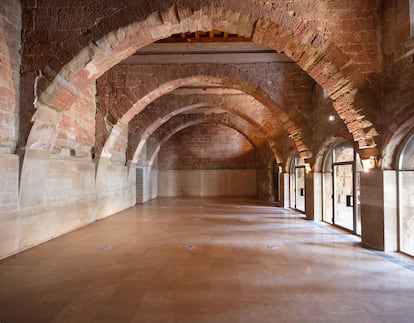The execution of the sentence on the restitution of the Romanesque works of the monastery of Sijena that are exhibited in the National Museum of Art of Catalonia (MNAC) threatens to become an avalanche of writings capable of saturating the Court of Instruction number 2 of Huesca. More than a decade after the judicial process began, with the sentence already firm after the endorsement of the Supreme Court, the Aragonese government (in addition to the City Council of Villanueva de Sijena) and the Catalan Museum present writings and counter -written that each defend their position: the executive of Jorge Azcón demands that the ruling is already executed; The MNAC, which prioritizes the preservation of an artistic and historical legacy with eight centuries of history that threatens ruin if its environmental conditions are altered.
Last Friday, the MNAC registered the last of the writings presented so far in court and will not be the last in that last battle that seems to get rid of the courts. He wants to know the conditions of the Chapter Room of the Monastery of Santa María de Sijena, the place where the paintings that covered a good part of their arches and walls as the only formula to save them out of the open. The director of the museum, Pepe Serra, already made clear a few weeks ago that the process of transferring what remains of those fragile murals consisted of three parts (disassembly, transport and delivery) and that it was impossible to elaborate a plan without knowing each of them.
In the case of delivery, we must know where they will go, although the writing does not specify if it also refers to the environmental conditions of the infrastructure (reforming in recent years but from which there is no accreditation that it is able to house and preserve in conditions its old legacy), since the conservatives have warned that if they are modified a lot with respect to the current standards, the degradation process could be accelerated.
“A global vision of the conservation project implies taking into account that the stages of diagnosis, assessment and risk management, preparation of the work, disassembly, packaging and transfer – says the brief, to which the country has had access – are related to the subsequent installation in the place of destination. This last task requires in a necessary way the collaboration of the performer, who must provide at the time time Previous phases also require that the performer provide certain information. ” That is, they demand the help of the Aragonese government, which is now organically depends on the monastery of Sijena. Pepe Serra has expressed before the judge his availability to explain himself the conditions of the painting.
In addition to the environmental conditions, the MNAC conservation team alleges that the supports on which the remains of the Romanesque murals are placed right now make it impossible to place those racks on the arches of the chapter room. On the destiny of the works there are, however, differences of criteria. The City of Sijena has defended before the judge that the word “restitution” used in the sentence does not mean to return exactly to the place where the murals were painted, but to its legitimate owner. That would open the door to expose them in other places. The MNAC, on the other hand, defends that this verb means returning to the original space.
In any case, the Catalan Museum, in whose Board of Trustees, Generalitat, Ministry of Culture and Barcelona City Council insists on the weakness of the works, because of the fire they suffered before they were torn, and the final danger that any movement represents. From the vibrations that suffer in disassembly and transport to the physical and chemical changes that may suffer with the change of temperature conditions and, especially moisture. The MNAC also emphasizes that, in order to comply with the European Cultural Heritage Conservation Standards, before making any movement it is necessary to make an updated diagnosis of its status. Therefore, photogrammetry, planimetry reports are being made, a map of the constructive structure and the union points (basic for its adjustment in Sijena), definition of points where the paint undergoes losses of adhesion, analysis of the volatile organic compounds of the wood on which the old murals rest. “These studies only corroborate the conclusions expressed previously about the fragility of these paintings and the true risk of damaging them irreparable in their withdrawal and subsequent transfer,” says the writing.
The letter sent to the court reiterates that the execution can be executed at two speeds. While the paintings torn in 1936 and affected by the fire are more vulnerable and will require a calendar established with much stricter conditions, the MNAC opens the door to advance in the return of some works started in 1960 and that were in a stay between the cloister and the church, an area not affected by the flames. The restitution of these paintings are more assumed with the usual processes in this type of operations.

